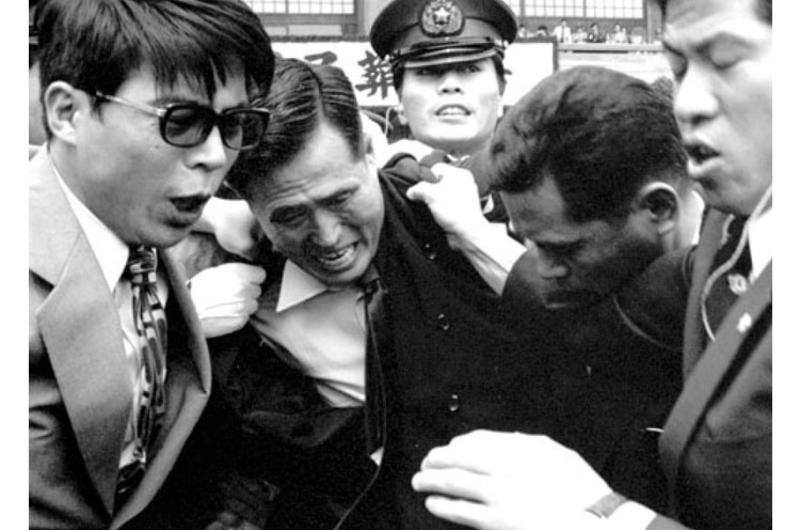

This website was created and maintained from May 2020 to May 2021 to commemorate the 75th anniversary of Stars and Stripes operations in the Pacific.
It will no longer be updated, but we encourage you to explore the site and view content we felt best illustrated Stars and Stripes' continued support of the Pacific theater since 1945.
Miki knocked down by attacker at Sato rites

Hiroyoshi Fudeyasu is grabbed by security guards after his attack on Miki.
By JIM LEA | Stars and Stripes June 18, 1975
TOKYO — A 34-year-old ultra-rightist dashed from a crowd of newsmen and mourners waiting for the start of a national funeral for former Prime Minister Eisaku Sato Monday and struck Prime Minister Takeo Miki three times in the face, knocking him to the ground.
Miki, 68, was helped to his feet immediately by aides who said he was uninjured in the attack. He was visibly shaken by the incident, however.
Twenty-three bodyguards and plainclothes police were within a few feet of the prime minister when a man identified as Hiroyoshi Fudeyasu, secretary general of the Great Japan Patriotic Party, darted from the crowd waiting in front of Tokyo's Nippon Budokan and struck Miki. Police subdued him quickly and hustled him from the area.
The incident lasted less than two minutes and caught police and bystanders completely by surprise. Only persons in the immediate vicinity of Miki knew what had happened, and most guests inside the hall did not know about the attack until the ceremony ended.
Police said late Monday that Fudeyasu had a record of 81 arrests, at least one of them involving another public figure. A spokesman said he was arrested in March 1962 for throwing a bottle of ink at a plane carrying then-Foreign Minister Aiichiro Fujiyama to China.
A spokesman said he told investigators he attacked Miki because of the prime minister's support of the Nuclear Non-Proliferation Treaty. He carried a hunting knife with a five-inch-long blade and a letter urging Miki to commit suicide.
Pacific Stars and Stripes photographer Hideyuki Mihashi, who was standing nearby at the time of the attack, said Fudeyasu darted from the crowd at 1:52 p.m., five minutes before the arrival of a limousine carrying Sato's widow, eldest son and his ashes.
Witnesses said Miki kept repeating, "I'm all right, I'm all right," as he was helped from the ground.
Mihashi said police who collared the attacker shouted, "You fool! Why do you do this here?"
(UPI reported Miki had an X-ray test after the incident and Dr. Saburo Yoshimoto and Dr. Yuzuru Inaba said later the prime minister suffered no major injuries except an abrasion on the left side of his nose and a bruise in the mouth.
(However, they advised him to take a rest and Miki agreed to skip a cabinet meeting scheduled for Tuesday morning.)
Five minutes after the attack, Sato's family arrived and Miki, his face impassive, led them into the hall where more than 6,000 persons had gathered to pay final tribute to Japan's only Nobel Peace Prize winner who died June 6 after suffering a stroke 15 days earlier.
Inside the hall, an altar covered with yellow and white chrysanthemums and a Japanese flag made from red and white chrysanthemums was dominated by a huge, black-draped photograph of Sato. Twenty-six decorations he received from his own and foreign governments also were displayed on the altar which was decorated at either side with Sato's calligraphy, the single character "wa." Meaning "a circle." It also is the last syllable in the Japanese word for "peace" and the first syllable in the word for "harmony."
As Sato's ashes were brought in, a Self-Defense Force saluting battery fired a 19-gun salute. Sato's eldest son, Ryutaro, handed the urn to Miki who appeared to be still shaken by the attack. Ryutaro Sato reached forward to steady him.
Japan's Crown Prince Akihito, Crown Princess Michiko, Prince and Princess Hitachi, Prince Tomohito — the emperor's nephew — and an Imperial Household Agency chamberlain representing the emperor and empress attended the ceremony along with representatives of 91 foreign governments,
Among the foreigners attending were Mrs. Imelda Marcos, wife of the Philippine president; U. Alexis Johnson, U.S. ambassador to Japan during part of Sato's term as prime minister; and Prime Minister Kim Jong-Pil of South Korea.
Miki, other government leaders and writer Sohachi Yamaoka, representing Sato's personal friends, all delivered eulogies. Most praised Sato's winning of the Nobel Prize and the return of Okinawa which he forged during his administration and which he felt was his greatest contribution to the nation.
At 4 p.m., the hall was opened to the public to say their last good-byes to the man who held the prime minister's post longer than any man in history — seven years, eight months.
Police said more than 30,000 persons had filed past the altar by 8 p.m.


